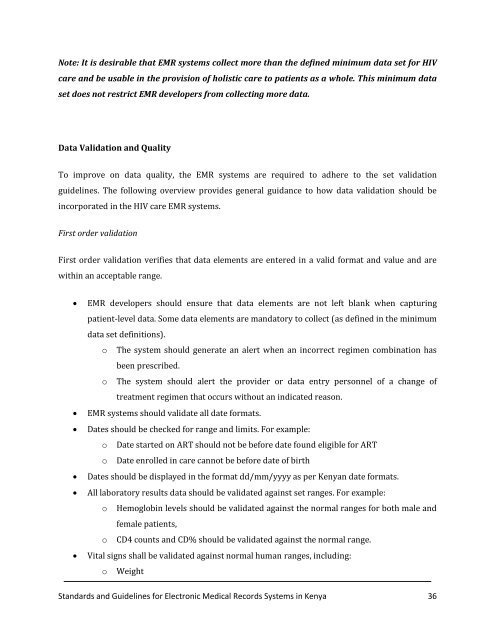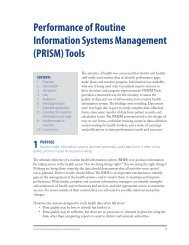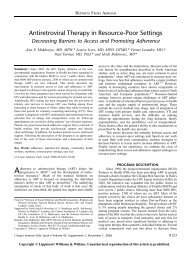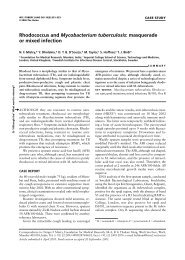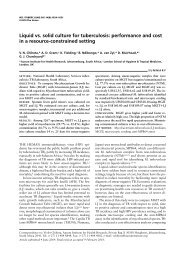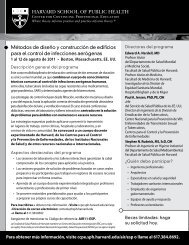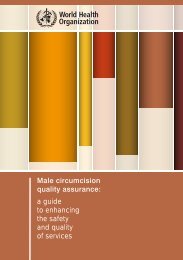Standards and Guidelines for Electronic Medical Record Systems in ...
Standards and Guidelines for Electronic Medical Record Systems in ...
Standards and Guidelines for Electronic Medical Record Systems in ...
Create successful ePaper yourself
Turn your PDF publications into a flip-book with our unique Google optimized e-Paper software.
Note: It is desirable that EMR systems collect more than the def<strong>in</strong>ed m<strong>in</strong>imum data set <strong>for</strong> HIV<br />
care <strong>and</strong> be usable <strong>in</strong> the provision of holistic care to patients as a whole. This m<strong>in</strong>imum data<br />
set does not restrict EMR developers from collect<strong>in</strong>g more data.<br />
Data Validation <strong>and</strong> Quality<br />
To improve on data quality, the EMR systems are required to adhere to the set validation<br />
guidel<strong>in</strong>es. The follow<strong>in</strong>g overview provides general guidance to how data validation should be<br />
<strong>in</strong>corporated <strong>in</strong> the HIV care EMR systems.<br />
First order validation<br />
First order validation verifies that data elements are entered <strong>in</strong> a valid <strong>for</strong>mat <strong>and</strong> value <strong>and</strong> are<br />
with<strong>in</strong> an acceptable range.<br />
· EMR developers should ensure that data elements are not left blank when captur<strong>in</strong>g<br />
patient-level data. Some data elements are m<strong>and</strong>atory to collect (as def<strong>in</strong>ed <strong>in</strong> the m<strong>in</strong>imum<br />
data set def<strong>in</strong>itions).<br />
o The system should generate an alert when an <strong>in</strong>correct regimen comb<strong>in</strong>ation has<br />
been prescribed.<br />
o The system should alert the provider or data entry personnel of a change of<br />
treatment regimen that occurs without an <strong>in</strong>dicated reason.<br />
· EMR systems should validate all date <strong>for</strong>mats.<br />
· Dates should be checked <strong>for</strong> range <strong>and</strong> limits. For example:<br />
o Date started on ART should not be be<strong>for</strong>e date found eligible <strong>for</strong> ART<br />
o Date enrolled <strong>in</strong> care cannot be be<strong>for</strong>e date of birth<br />
· Dates should be displayed <strong>in</strong> the <strong>for</strong>mat dd/mm/yyyy as per Kenyan date <strong>for</strong>mats.<br />
· All laboratory results data should be validated aga<strong>in</strong>st set ranges. For example:<br />
o Hemoglob<strong>in</strong> levels should be validated aga<strong>in</strong>st the normal ranges <strong>for</strong> both male <strong>and</strong><br />
female patients,<br />
o CD4 counts <strong>and</strong> CD% should be validated aga<strong>in</strong>st the normal range.<br />
· Vital signs shall be validated aga<strong>in</strong>st normal human ranges, <strong>in</strong>clud<strong>in</strong>g:<br />
o Weight<br />
<strong>St<strong>and</strong>ards</strong> <strong>and</strong> <strong>Guidel<strong>in</strong>es</strong> <strong>for</strong> <strong>Electronic</strong> <strong>Medical</strong> <strong>Record</strong>s <strong>Systems</strong> <strong>in</strong> Kenya 36


